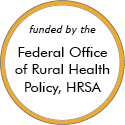Rural Project Examples: Elderly population
Evidence-Based Examples
Fit & Strong!®
Updated/reviewed November 2025
- Need: Osteoarthritis is a chronic condition which often causes multiple related disabilities in older adults.
- Intervention: An evidence-based curriculum incorporating physical activity, behavior change, and fall prevention geared to older adults with lower extremity osteoarthritis.
- Results: Participants experienced less stiffness, improved joint pain, improved lower extremity strength and mobility, in addition to creating their own unique program for continued post-class use.
Telepsychology-Service Delivery for Depressed Elderly Veterans
Updated/reviewed April 2025
- Need: To provide evidence-based psychotherapy for depression in elderly veterans who are unable to seek mental health treatment due to distance or stigma.
- Intervention: Telepsychology-Service Delivery for Depressed Elderly Veterans compared providing behavioral activation therapy via home-based telehealth and the same treatment delivered in a traditional office-based format.
- Results: A 2015 study and two 2016 studies show that providing treatment via home-based telehealth to elderly veterans in South Carolina resulted in the same improved health outcomes, quality of life, satisfaction with care, and cost of healthcare compared to those receiving face-to-face treatment.
StrongPeople® Program
Updated/reviewed July 2024
- Need: Few older adults, particularly women and those in rural areas, participate in healthy living interventions.
- Intervention: Health educators lead community-based healthy living classes, which include strength training, aerobic exercise, dietary skill building, and/or civic engagement, depending on the program.
- Results: StrongPeople® programs have been shown to improve weight, diet, physical activity, strength, cardiovascular health profile, physical function, pain, depression, and/or self-confidence in midlife and older adults.
Effective Examples
Livingston County Help For Seniors

Updated/reviewed May 2020
- Need: Meeting the health needs of geriatric patients in rural Livingston County, New York.
- Intervention: The Help for Seniors program was developed and using its 'vodcasts,' local EMTs were trained in geriatric screening methods and health needs treatment.
- Results: In addition to developing a successful model for educating EMS personnel, the program screened over 1200 individuals and identified various risks among the geriatric population.
Promising Examples
SASH® (Support and Services at Home)
Updated/reviewed April 2025
- Need: In Vermont, the growing population of older adults, coupled with a lack of a decentralized, home-based system of care management, poses significant challenges for those who want to remain living independently at home.
- Intervention: SASH® (Support and Services at Home), based in affordable housing and their surrounding communities throughout the state, works with community partners to help older adults and people with disabilities receive the care they need so they can continue living safely at home.
- Results: Compared to their non-SASH peers, SASH participants have been documented to have better health outcomes, including fewer falls, lower rates of hospitalizations, fewer emergency room visits, and lower Medicare and Medicaid expenditures.
Other Project Examples
Men's Conversation Group
Updated/reviewed November 2025
- Need: Suicide rates among men age 65 and older have been rising in North Carolina. Challenges include losing friends, illnesses, and the loss of independence – all of which can lead to isolation and depression.
- Intervention: Chatham County Aging Services of North Carolina started the Men's Conversation Group to connect retired men in need of male friends and mutual support.
- Results: Men in similar stages of life and varying backgrounds are forming friendships, engaging in activities, and taking care of their mental health.
Lakewood Food Access Initiatives
Updated/reviewed October 2025
- Need: Parts of rural Todd County, Minnesota and surrounding areas are classified as food deserts, where many rural families face food insecurity and low availability of both nutritious and affordable provisions.
- Intervention: A collection of programs address food insecurity and the dietary health of members of the community, from children and families to older adults, supplying them with locally sourced fruits, vegetables, and meat.
- Results: Lakewood Health System conducts around 50,000 food insecurity screenings each year. Fresh produce, meat, and other goods are distributed to roughly 140 families (around 500 individuals), 75 seniors, and 75 school-aged children annually.
Age-Friendly and Dementia-Friendly Winnemucca
Updated/reviewed August 2025
- Need: To educate rural community members about Alzheimer's disease and other dementias and to support older adults with dementia and caregivers in need.
- Intervention: A community group formed in Winnemucca, Nevada, to discuss topics like health, housing, social events, community improvement, education, and transportation for older adults. The group also provides outreach to older adults, caregiver support, and a variety of educational activities and events.
- Results: The group's efforts have led to many changes for community welfare and safety as well as opportunities for education and activities.
CAPABLE (Community Aging in Place—Advancing Better Living for Elders)
Updated/reviewed July 2025
- Need: To help older adults age in place.
- Intervention: For four to five months, CAPABLE participants receive home visits from a registered nurse, occupational therapist, and home repair services.
- Results: There are currently 38 CAPABLE sites across the country, 19 of which are located in rural communities.
Rural Aging Action Network
Updated/reviewed January 2025
- Need: To connect isolated older adults and family caregivers in rural Minnesota, Montana, North Dakota, and South Dakota to services and supports so they can age in place.
- Intervention: The Rural Aging Action Network is a national collaborative of organizations that mobilize whole communities to address gaps in care for older adults and family caregivers.
- Results: Since 2022, the collaborative has reached over 600 older adults and over 100 family caregivers living in rural communities.
For examples from other sources, see:
